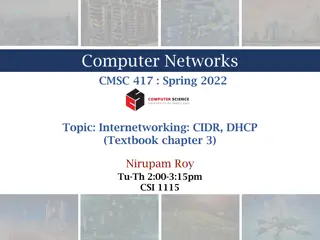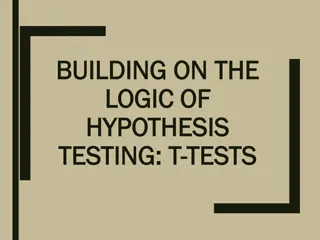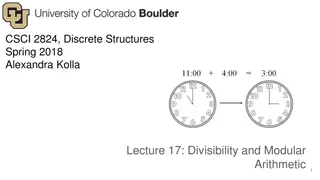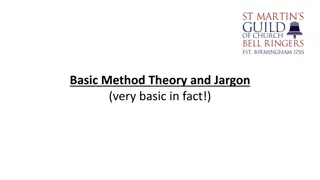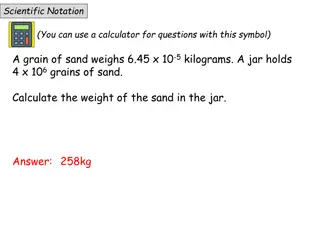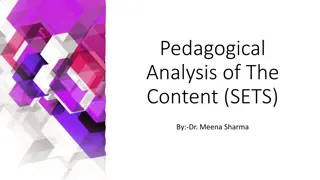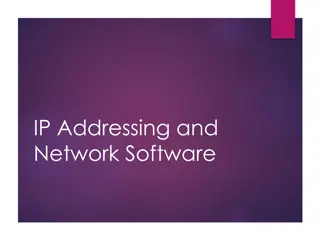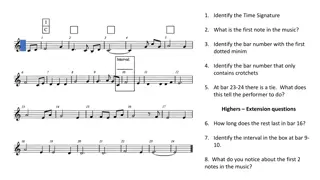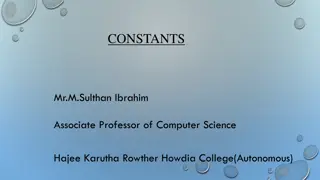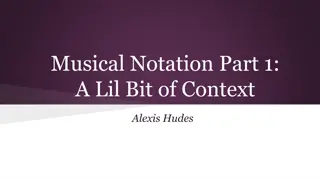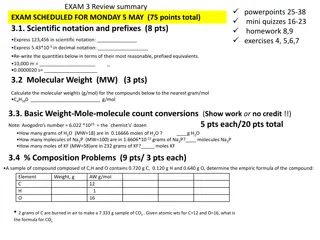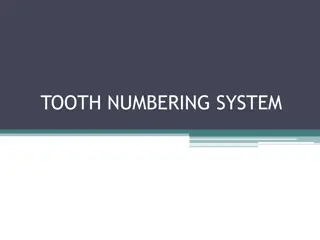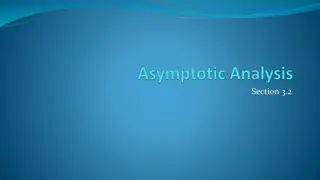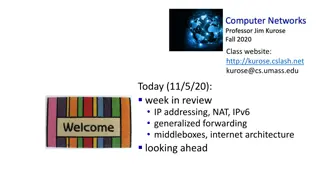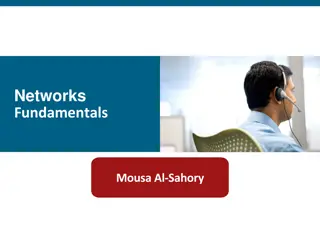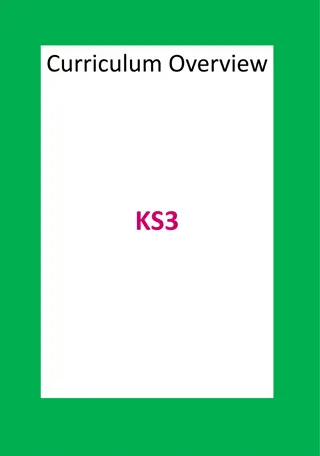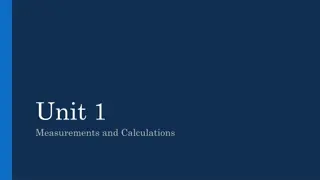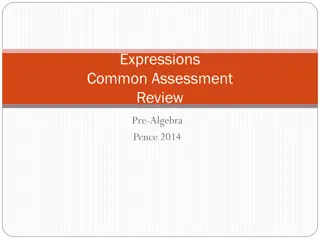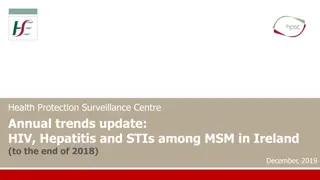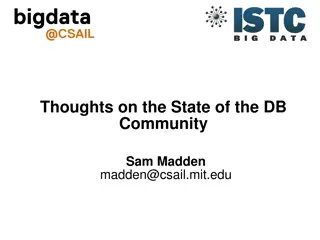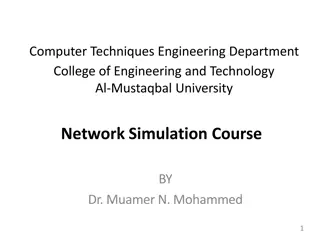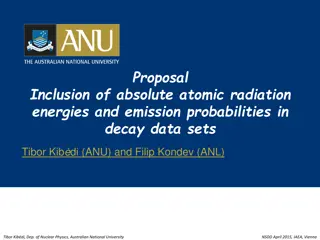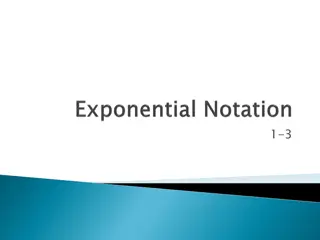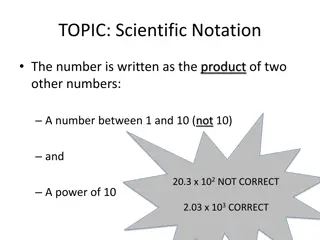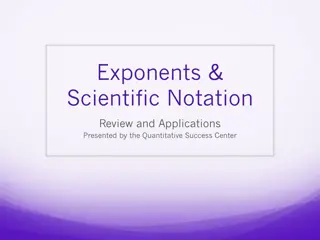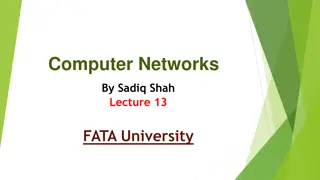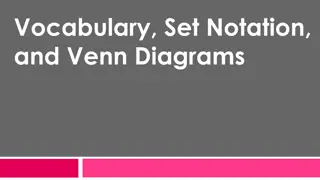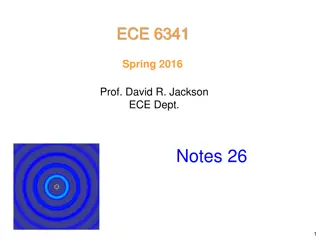Computer Networks CMSC 417 : Spring 2022
Exploring the concepts of Classless Interdomain Routing (CIDR) and Dynamic Host Configuration Protocol (DHCP) in the context of internetworking. CIDR simplifies subnetting by allowing for classless addressing, hiding network hierarchies, and enabling supernetting. Lessons learned from subnetting inc
0 views • 57 slides
Understanding Multiple Linear Regression: An In-Depth Exploration
Explore the concept of multiple linear regression, extending the linear model to predict values of variable A given values of variables B and C. Learn about the necessity and advantages of multiple regression, the geometry of best fit when moving from one to two predictors, the full regression equat
4 views • 31 slides
Understanding Vector Operations in Linear Algebra
Explore the world of vector operations in linear algebra through this detailed presentation. Learn about vector addition, scalar multiplication, field operations, and more. Gain insights into the notation of Fn and the significance of scalar multiplication and vector addition in linear algebra. Whet
8 views • 9 slides
COMPUTER ORGANISATION Register Transfer Language
Register Transfer Language is a symbolic notation used to describe the micro-operations transferring data among registers in computer organisation. It signifies the availability of hardware logic circuits to perform specified micro-operations and transfer results between registers. Register Transfer
6 views • 7 slides
Problem-solving with Venn Diagrams
Explore various Venn diagram problems involving ownership of pets, student studies, probability calculations, and set notation. Understand how to determine the shaded sections in Venn diagrams, calculate the number of people owning both cats and dogs, find the probability of selecting a student stud
1 views • 10 slides
Understanding Hypothesis Testing with T-Tests and Z-Scores
Explore the process of hypothesis testing using t-tests and z-scores, including limitations, steps, and proper statistical notation. Learn how to handle unknown values and the difference between one-tailed and two-tailed tests.
0 views • 30 slides
Learning How to Read Music: Part 1 Explained
Dive into the fundamentals of reading music in Part 1 of this comprehensive guide. Explore topics such as pitch, instruments, staves, clefs, and symbols, providing a solid foundation for understanding music notation. Enhance your knowledge with visuals and clear explanations.
1 views • 15 slides
Understanding Divisibility and Modular Arithmetic in Discrete Structures
This lecture discusses the concepts of divisibility and modular arithmetic in the context of discrete structures. It covers definitions, notation, and examples of divisibility by integers, including proving properties such as the divisibility of products and consecutive integers. Through practical e
0 views • 43 slides
Introduction to Basic Music Theory Concepts and Notation
Delve into the fundamental elements of music theory, exploring notation, scales, and chord progressions through visual representations. Learn how to read and interpret musical symbols, paving the way for a deeper understanding of music composition.
2 views • 13 slides
Mathematics Practice Problems - Fractions, Percentages, Scientific Notation, and Expanding Brackets
Practice various mathematics topics such as fractions, percentages, scientific notation, and expanding brackets with sample problems and solutions.
0 views • 66 slides
Pedagogical Analysis of Sets in Mathematics: Key Concepts and Teaching Strategies
Explore the pedagogical analysis of SETS by Dr. Meena Sharma, focusing on major concepts like the meaning of SET, SET notation, classification of SETS, and fundamental operations. Understand minor topics such as examples of sets, SET notation methods, and types of SETS. Objectives include defining S
0 views • 8 slides
Understanding Enemark-Feltham Notation in Iron-Nitrosyl Complexes
Iron-Nitrosyl complexes are redox non-innocent, with NO exhibiting multiple redox states. Enemark-Feltham Notation helps in determining metal-ligand interactions and oxidation states. Detailed information on NO ligands, bonding characteristics, and methods for analyzing iron-NO systems are discussed
0 views • 6 slides
Math Set Notations and Probability Practice
Practice set notation and probability with quizzes on set notation, Venn diagrams, and probability calculations based on survey results. Improve your math skills through visual exercises and calculations.
0 views • 19 slides
Understanding IP Addressing and Conversion from Binary to Decimal
Learn about IP addressing, including binary notation, dotted-decimal notation, and the process of converting binary numbers to decimal. Explore the unique features of IP addresses and the steps involved in converting binary to decimal systematically.
3 views • 47 slides
Music Notation Analysis Questions and Answers
This content provides a series of music notation analysis questions with corresponding images for practice and learning purposes. The questions cover topics such as identifying time signatures, notes, rests, intervals, keys, and specific bars with certain musical elements like ties, dotted minim, cr
0 views • 12 slides
Understanding Different Types of Constants in Programming
Constants in programming are fixed values that do not change during program execution. They include character, numerical, and string constants. Integer constants can be decimal, octal, or hexadecimal. This article explains each type of constant with examples of decimal, octal, and hexadecimal intege
0 views • 22 slides
Explore the Benefits of Music Notation Software for Educators and Students
Discover the advantages of using music notation software in education, from enhancing creativity and exploration to facilitating composition and arrangement tasks. Learn about popular programs like Musescore, Sibelius, and GarageBand, and empower students to write music for various genres and purpos
0 views • 11 slides
Evolution of Musical Notation Systems and Contexts
Explore the diverse world of musical notation systems, from Eastern to Western traditions, spanning Babylonian notations, Guido d'Arezzo's contributions, Gregorian chants, and modern-day tempo measures. Uncover the rich history and nuances of musical expression through various scales, staves, orname
0 views • 12 slides
Chemistry Exam Review: Topics in Scientific Notation, Molecular Weight, Stoichiometry, and Limiting Yield
Explore key concepts in chemistry, including scientific notation, molecular weight calculations, reaction balancing, stoichiometry, and limiting yield problems. Prepare for an upcoming exam by practicing various problems and conversions related to these topics, such as expressing numbers in scientif
0 views • 4 slides
Understanding Tooth Numbering Systems in Dentistry
Dental professionals use various tooth numbering systems to identify and record teeth in the mouth. The three main systems are Universal Notation, Zsigmondy/Palmer Notation, and Federation Dentaire Internationale (FDI). Universal Notation utilizes letters for primary teeth and numbers for permanent
0 views • 19 slides
Understanding Big-Oh Notation in Time Complexity Analysis
Big-Oh notation in algorithm analysis signifies how the runtime of an algorithm grows in relation to the input size. It abstractly characterizes the worst-case time complexity, disregarding constants and lower-order terms. The concept of Big-Oh, along with Big-Omega and Big-Theta, helps in comparing
0 views • 18 slides
Understanding IP Addressing and Routing in Networking
Delve into the fundamentals of IP addressing, CIDR, subnetting, and network layer protocols like TCP and UDP. Explore the intricacies of Internet architecture, NAT, IPv6, and forwarding techniques. Grasp the essentials of IP datagram format, path-selection algorithms, SDN, and more for a comprehensi
0 views • 22 slides
Understanding IPv4 Addressing and Classes
Explore the fundamentals of IPv4 addressing including subnetting, VLSM, summarization, subnet masks, CIDR values, available host addresses, and broadcast addresses. Learn about IPv4 classes A, B, C, and D, their formats, usage for different network sizes, netmask details, IP address ranges, and more
0 views • 38 slides
Music Notation and Interpretation in KS3 Curriculum
Explore music notation in KS3 Music curriculum, focusing on reading and writing notes from E up to F on the treble clef. Understand various forms of notation such as graphic scores and enhance your musical literacy skills throughout the academic year.
0 views • 89 slides
Understanding Scientific Notation and SI Measurement Basics
Explore scientific notation as a method for expressing large and small numbers efficiently in mathematical calculations. Practice converting numbers into scientific notation and learn the rules for multiplication, division, addition, and subtraction in this format. Additionally, discover the benefit
0 views • 41 slides
Pre-Algebra Review: Expressions and Exponents
This pre-algebra review covers topics such as evaluating expressions, working with exponents, using scientific notation, and standard form notation. Examples and answers help reinforce understanding of fundamental algebraic concepts.
0 views • 29 slides
Understanding Scientific Notation in Mathematics and Chemistry
Scientific notation is an essential concept for representing very large or very small numbers efficiently. It simplifies numbers by expressing them as a coefficient multiplied by a power of 10. This summary covers the basics of scientific notation, from converting numbers to and from scientific nota
0 views • 55 slides
Health Protection Surveillance Centre Annual Update: HIV, Hepatitis, and STIs Trends Among MSM in Ireland (End of 2018)
The Health Protection Surveillance Centre presents the annual trends update on HIV, Hepatitis, and STIs among Men Who Have Sex with Men (MSM) in Ireland up to the end of 2018. The report explores the overall trends in HIV diagnoses and rates, probable routes of transmission, previous diagnosis histo
0 views • 35 slides
Thoughts on the State of the DB Community by Sam Madden
Sam Madden from MIT CSAIL shares insights on community conferences, advocating for single-track events to enhance the attendee experience and increase paper impact. He suggests creating a prestigious super conference with high-quality papers from the entire community, similar to CIDR but with better
0 views • 8 slides
Understanding Molar Mass and Avogadro's Number in Chemistry
Explore the concept of molar mass and Avogadro's number in chemistry through lessons on translating numbers into scientific notation, understanding moles, and finding molar mass on the periodic table. Discuss the relationship between mass and moles, differentiate between different quantities of a su
1 views • 11 slides
Understanding Subnet Mask in Network Simulation Course
Dive into the world of subnet masks and CIDR notations in the context of network simulation. Learn to determine subnet masks, divide networks, and configure routers to optimize network efficiency. Practice subnetting with exercises and explore default subnet masks and CIDR values for enhanced networ
0 views • 12 slides
Integration of Atomic Radiation Energies and Emission Probabilities in Decay Data Sets
Proposal by Tibor Kibdi and Filip Kondev to include absolute atomic radiation energies and emission probabilities in decay data sets. They emphasize the need for energy and intensity data to be computer-readable and use standard notation. The inclusion of atomic relaxation data into ENSDF is discuss
0 views • 7 slides
Understanding Exponents: Simplifying Expressions and Scientific Notation
Explore the concept of exponents, learn how to simplify expressions with negative exponents, and delve into scientific notation for efficiently representing large numbers. Discover the basics of exponents, operations involving exponents, and the application of scientific notation in various discipli
0 views • 8 slides
Understanding Exponential Notation and Evaluating Expressions with Exponents
Learn about the vocabulary related to exponential notation, how to write expressions with exponents, and how to evaluate expressions with exponents both inside and outside parentheses. Practice problems included to enhance understanding.
0 views • 17 slides
Understanding Scientific Notation: Converting, Multiplying, Dividing & More
Scientific notation is a way to express large or small numbers efficiently. Learn how to convert numbers to and from scientific notation, multiply and divide in scientific notation, and ensure proper formatting. Understand the rules for exponents and make calculations easier with these simple steps.
0 views • 8 slides
Understanding Scientific Notation and Conversions
Scientific notation is a useful way to express very large or very small numbers in a concise form. This chapter discusses how to convert numbers between scientific notation and decimal notation, providing examples and explanations for better understanding.
0 views • 18 slides
Understanding Exponents and Scientific Notation
Exponents are powers to which bases are raised, allowing for efficient representation and calculation of numbers. This review covers the basics of exponents, rules, laws, and practical applications. Scientific notation offers a method to express very large or small numbers using powers of 10. Learn
0 views • 13 slides
Understanding Addressing in Computer Networks
Addressing in computer networks plays a crucial role in efficient communication. Classful addressing, which led to address depletion, has made way for classless addressing and CIDR strategy. In classless addressing, the address space is divided into variable length blocks, allowing for more flexibil
0 views • 17 slides
Understanding Set Notation and Probability in Visuals
Explore the concepts of vocabulary, set notation, Venn diagrams, probability, experiments, outcomes, sample space, events, unions, intersections, complements, and set notation through visual aids and clear explanations. Learn about subsets, empty sets, and more in this comprehensive resource from Wa
0 views • 24 slides
Understanding EM Plane-Wave Transformation Notes
In these notes by Prof. David R. Jackson for ECE 6341, the concept of EM plane-wave transformation is discussed in detail. It covers topics such as the relationship between Er and Ar, Hr and Fr, field components representation, integration formulas, and notation usage like Harrington notation. The c
0 views • 17 slides
